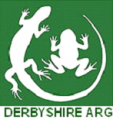About us
About Us
Welcome to Derbyshire Amphibian and Reptile Group we cover the whole of Derbyshire including part of the Peak District National Park.and the National Forest
Our group aims to promote the study and conservation of the amphibians and reptiles of Derbyshire and their habitats. We achieve this by:
- raising awareness of the ecology and conservation needs of Derbyshire's amphibians and reptiles
- undertaking practical conservation projects
- running approximately 20 Toads on Road patrols at locations across the county every spring during the toad migration season
- carrying out regular reptile surveys and amphibian surveys
- organising amphibian and reptile training sessions for members and the public
- providing advice and information and answering queries for the public
- developing recording, monitoring and research intitatives
- providing a forum for those interested in amphibians and reptiles
- working in partnership with other relevant organisations
We hope our website will help you to find the information you are looking for, but if you still have a query, please contact us and we will do our best to help.
Derbyshire ARG always welcome new members to the group, please email us on derbyshirearg@gmail.com to join. There is a membership subscription of £5 per year, though that is reviewed at every AGM..
We are very grateful for any records of amphibians and reptiles in your local area that you can pass to us as it helps in mapping the distribution of species and protecting their known habitats. Either contact us directly or use the Record a sighting tab on this website.
The group is run by a committee which is elected at the AGM each year. For 2024 - 2025 the committee elected at the AGM on 13th January 2024 are:
Chair - Kelvin Lawrence, Vice Chair - Christian Murray-Leslie, Secretary - Chris Monk, Treasurer - Jayne Thompson
Committee members - Garry Dorrell, Chris Hallam, James Longley, Sheila Stubbs and Ben Wyke
Kelvin Lawrence is also the Derbyshire Toad Crossings Co-ordinator for the Group & for Froglife
See a previous newsletters here
![]() January_2021_DARG_newsletter_31.pdf
January_2021_DARG_newsletter_31.pdf
![]() August_2020_DerbyshireARG_newsletter.pdf
August_2020_DerbyshireARG_newsletter.pdf
![]() February_2020_DARG_Events_newsletter.pdf
February_2020_DARG_Events_newsletter.pdf
![]() DARG_April_2019_newsletter.pdf
DARG_April_2019_newsletter.pdf
![]() DARG_January_2019_newsletter.pdf
DARG_January_2019_newsletter.pdf
Derbyshire ARG data policy
![]() DARG_data_protection_policy_November_2018.pdf
DARG_data_protection_policy_November_2018.pdf
News
News
Adder survey site destroyed by fire
A large moorland fire on Monday 21st May following a period of warm dry weather has burnt 43 hectares of the Peak District Eastern Moors SSSI before eventually being extinguished. Unfortunately one of our regular adder survey sites has been destroyed along with eggs of ground nesting birds and the habitat there could easily take 10 years to recover to a condition where it would be suitable for lizards and adders. The Derbyshire Fire and Rescue Service, said: "It is believed to be suspicious ignition, possibly deliberate, but that is something for the police and Eastern Moors staff to establish."
This was the second moorland fire in May after another fire, again thought to have been deliberately started, destroyed an area in the Goyt Valley SSSI including many bird nests.
Both sites are in the South Pennine Moors Special Area of Conservation (SAC) and the Peak District Moors (South Pennine Moors phase 1) Special Protection Area (SPA).
Winter returns with a vengeance
After the significant snowfall and cold weather in late February and early March that held back the start of the 2018 amphibian season, put a break on the reptile emergence surveys and postponed our spring meeting, it has all come to a halt again on Sat 17th with cold weather and snowfall blanketing the county especially the upland areas in the Peak District. Toads had just started moving last week especially in southern Derbyshire, frogs were spawning across the county and some reptiles were basking and now it has all come to a halt. Hopefully it will be full speed ahead for frogs and toads later this coming week with mild & wet weather forecast, though it doesn't look good for the reptiles. However we have just purchased a further supply of toad migration road signs to add to our stock and they will be put up this week as soon as the snow has cleared.
Spring Meting postponed
The Group's Spring Meeting and AGM due to be held on Saturday 3rd March has been cancelled due to the heavy snow and ice. It will be re-arranged for later on this spring when the weather is better.
Conservation day organised for local ecological consultancy
Derbyshire ARG orgnised a mornings practical conservation work for ecology staff from one of the various ecological consultancies in Derbyshire. Clearance of Typha and other vegetation was undertaken to two ponds created a decade ago for a small scale great crested newt mitigation but later passed onto the Wildlife Trust for management. No great crested newts have been found in regular surveys of the site but the ponds are important from frogs, toads and smooth newts. Discussion was held on site with the ecologists over their views on habitat management or improvements needed, value of great crested newt mitigation and whether it works. It is hoped to organise a few other conservation events for the company and any others who might be interested over the next year.
Derbyshire ARG Pond surveys spring 2017
The Group ran a series of pond surveys this spring to monitor amphibians, particularly great crested newts but also palmate and smooth newts, in ponds in the White Peak area of the Peak District National Park. These involved 9 ponds on 3 different nature reserves belonging to the Derbyshire Wildlife Trust to add to their species monitoring data. Also we visited 6 ponds on two different farm holdings at the request of their owners and the Peak District National Park Authority farm advisers. In addition for the second year running we visited the pond near Hartington which had been randomly selected by Freshwater Habitats Trust for their PondNet great crested eDNA survey. The surveys were also advertised to people who had been on our great crested newt training courses so that they could gain more field experience in bottle trapping, torchlight surveys and eDNA water sampling.
Events
Events
Bakewell Country Festival
Sun 13th July, 2025 - Sun 13th July, 2025
We will be having a stand at the one day event on the Bakewell Agricultural Showground
Group Membership
Group Membership
Derbyshire ARG will be introducing an annual membership fee in 2025.
It is planned to come into affect in the spring at a rate of £5.00
Further details to follow.
Photo gallery
Photo Gallery
Contact us
Contact Us
DerbysARG
Matlock
Derbyshire
DE4 4NF
For Toad Crossings and to contact our Derbyshire Toad Crossings Co-ordinator please email derbyshirearg.toads@gmail.com
Upcoming Events
- Bakewell Country Festival
13th Jul, 2025 - 13th Jul, 2025
Latest News
- Stanage & North Lees lizard surveys
25/10/2024 9:33 am - Rewilding success at British Mountaineering Council owned Horseshoe Quarry
15/06/2024 3:37 pm - 2023 Surveys and Events
22/09/2023 5:00 pm - Nature and Species Recovery in Derbyshire
12/02/2023 5:01 pm - Linacre reservoirs reptile survey
16/09/2022 8:05 pm
© Derbyshire Amphibian and Reptile Group
Website hits: 40995
View All | Find out how to get a mini-website for your ARG
© ARG UK Local Groups mini-websites 2025
Wind powered websites by Aye-aye Design.

